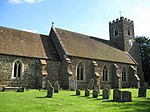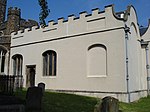Pulloxhill Grange
Bedfordshire building and structure stubsMonasteries in BedfordshireUnited Kingdom Christian monastery stubs
Pulloxhill Grange was a priory in Bedfordshire, England. It is a Grade II listed building.In 1535, Dunstable Priory received from Woburn Abbey 5s. for land it held in Pulloxhill. In 1291, the value of the abbey's estates in Pulloxhill was £7 2s. 5d. In 1330, the abbey claimed sac and soc in Pulloxhill. In 1547, after the Dissolution of the monasteries, Pulloxhill Grange, was granted to Sir William Pagett.
Excerpt from the Wikipedia article Pulloxhill Grange (License: CC BY-SA 3.0, Authors).Pulloxhill Grange
High Street,
Geographical coordinates (GPS) Address Nearby Places Show on map
Geographical coordinates (GPS)
| Latitude | Longitude |
|---|---|
| N 51.994315 ° | E -0.453444 ° |
Address
The Cross Keys
High Street 13
MK45 5HB
England, United Kingdom
Open on Google Maps







